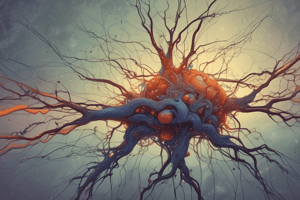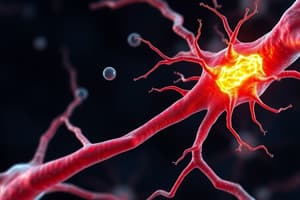Podcast
Questions and Answers
What is the primary mechanism by which botulinum toxin blocks the release of acetylcholine?
What is the primary mechanism by which botulinum toxin blocks the release of acetylcholine?
- By blocking voltage-sensitive calcium channels
- By inhibiting the activity of acetylcholinesterase
- By preventing the fusion of synaptic vesicles with the cell membrane (correct)
- By blocking voltage-sensitive sodium channels
What is the effect of the toxin in black widow spider venom on synaptic vesicles?
What is the effect of the toxin in black widow spider venom on synaptic vesicles?
- It prevents the release of acetylcholine from synaptic vesicles
- It inhibits the recycling of choline back into the neuron
- It causes the release of all acetylcholine stored in synaptic vesicles into the synaptic cleft (correct)
- It increases the synthesis of acetylcholine in synaptic vesicles
What is the primary function of acetylcholinesterase in the synaptic cleft?
What is the primary function of acetylcholinesterase in the synaptic cleft?
- To release acetylcholine from synaptic vesicles
- To synthesize acetylcholine
- To cleave acetylcholine into choline and acetate (correct)
- To bind to postsynaptic receptors
What is the role of butyrylcholinesterase in the synaptic cleft?
What is the role of butyrylcholinesterase in the synaptic cleft?
What is the mechanism by which choline is recaptured by the neuron?
What is the mechanism by which choline is recaptured by the neuron?
What is the characteristic of muscarinic receptors?
What is the characteristic of muscarinic receptors?
What is the effect of muscarine on muscarinic receptors?
What is the effect of muscarine on muscarinic receptors?
How many subclasses of muscarinic receptors are there?
How many subclasses of muscarinic receptors are there?
Which of the following receptors is not primarily involved in smooth muscle function?
Which of the following receptors is not primarily involved in smooth muscle function?
What is the effect of IP3 on intracellular Ca2+ levels?
What is the effect of IP3 on intracellular Ca2+ levels?
Which G protein is activated when M1 or M3 receptors are stimulated?
Which G protein is activated when M1 or M3 receptors are stimulated?
What is the primary effect of diacylglycerol (DAG) in acetylcholine signal transduction?
What is the primary effect of diacylglycerol (DAG) in acetylcholine signal transduction?
What is the primary effect of M2 receptor stimulation on cardiac muscle?
What is the primary effect of M2 receptor stimulation on cardiac muscle?
What is the primary mechanism of nicotine's effect at high concentrations?
What is the primary mechanism of nicotine's effect at high concentrations?
What is the primary location of nicotinic receptors in the nervous system?
What is the primary location of nicotinic receptors in the nervous system?
What is the primary function of nicotinic receptors in the NMJ?
What is the primary function of nicotinic receptors in the NMJ?
What is the primary action of bethanechol on the bladder?
What is the primary action of bethanechol on the bladder?
What is the therapeutic use of bethanechol in postpartum or postoperative cases?
What is the therapeutic use of bethanechol in postpartum or postoperative cases?
What is the effect of pilocarpine on the eye?
What is the effect of pilocarpine on the eye?
What is the duration of action of pilocarpine in lowering intraocular pressure?
What is the duration of action of pilocarpine in lowering intraocular pressure?
Which receptor is responsible for the vasodilation caused by acetylcholine?
Which receptor is responsible for the vasodilation caused by acetylcholine?
What is the adverse effect of bethanechol that is treated with atropine sulfate?
What is the adverse effect of bethanechol that is treated with atropine sulfate?
What is the effect of acetylcholine on the heart rate?
What is the effect of acetylcholine on the heart rate?
What is the primary action of pilocarpine on salivation?
What is the primary action of pilocarpine on salivation?
What is the mechanism of action of acetylcholine in decreasing blood pressure?
What is the mechanism of action of acetylcholine in decreasing blood pressure?
What is the effect of atropine on acetylcholine?
What is the effect of atropine on acetylcholine?
In what condition is pilocarpine used to treat xerostomia?
In what condition is pilocarpine used to treat xerostomia?
What is the unique property of pilocarpine that allows it to penetrate the CNS?
What is the unique property of pilocarpine that allows it to penetrate the CNS?
What is the unique property of bethanechol?
What is the unique property of bethanechol?
What is the effect of acetylcholine on the gastrointestinal tract?
What is the effect of acetylcholine on the gastrointestinal tract?
What is the effect of acetylcholine on the genitourinary tract?
What is the effect of acetylcholine on the genitourinary tract?
What is the effect of acetylcholine on the eye?
What is the effect of acetylcholine on the eye?
What is the duration of action of neostigmine?
What is the duration of action of neostigmine?
What is one of the therapeutic uses of neostigmine?
What is one of the therapeutic uses of neostigmine?
What is a common adverse effect of neostigmine?
What is a common adverse effect of neostigmine?
What is the duration of action of pyridostigmine?
What is the duration of action of pyridostigmine?
What is the primary use of tacrine, donepezil, rivastigmine, and galantamine?
What is the primary use of tacrine, donepezil, rivastigmine, and galantamine?
What is a common adverse effect of tacrine, donepezil, rivastigmine, and galantamine?
What is a common adverse effect of tacrine, donepezil, rivastigmine, and galantamine?
What is the mechanism of action of echothiophate?
What is the mechanism of action of echothiophate?
What can reactivate the enzyme inactivated by echothiophate?
What can reactivate the enzyme inactivated by echothiophate?
Flashcards are hidden until you start studying
Study Notes
Acetylcholine Release and Binding
- Acetylcholine (ACh) release from the synaptic vesicles is triggered by an action potential, which opens voltage-sensitive calcium channels, increasing intracellular calcium levels.
- Elevated calcium levels promote the fusion of synaptic vesicles with the cell membrane, releasing ACh into the synaptic space.
- Botulinum toxin can block ACh release from the synaptic vesicles.
Binding to the Receptor
- ACh released from the synaptic vesicles diffuses across the synaptic space and binds to postsynaptic receptors on the target cell.
- Postsynaptic cholinergic receptors are divided into two classes: muscarinic and nicotinic receptors.
- Binding to a receptor leads to a biological response, which is mediated by second messenger molecules.
Degradation of Acetylcholine
- The signal is rapidly terminated by acetylcholinesterase (AChE), which cleaves ACh into choline and acetate in the synaptic cleft.
- Butyrylcholinesterase (also known as pseudocholinesterase) is found in the plasma but does not terminate the effect of ACh in the synapse.
Recycling of Choline
- Choline can be recaptured by a sodium-coupled transporter that transports the molecule back into the neuron.
Cholinergic Receptors (Cholinoceptors)
- There are two families of cholinoceptors: muscarinic and nicotinic receptors.
- Muscarinic receptors are G protein-coupled receptors (metabotropic receptors) that bind ACh and muscarine.
- Nicotinic receptors are ligand-gated ion channels that bind ACh and nicotine.
Muscarinic Receptors
- Muscarinic receptors have five subclasses: M1, M2, M3, M4, and M5.
- Only M1, M2, and M3 receptors are the most important receptors.
- M1 receptors are found on gastric parietal cells, M2 receptors on cardiac cells and smooth muscle, and M3 receptors on the bladder, exocrine glands, and smooth muscle.
- Activation of M1 or M3 receptors leads to the production of second messengers, including inositol-1,4,5-trisphosphate (IP3) and diacylglycerol (DAG).
Nicotinic Receptors
- Nicotinic receptors are found in the CNS, adrenal medulla, autonomic ganglia, and the neuromuscular junction (NMJ) in skeletal muscles.
- Nicotinic receptors can be stimulated by nicotine at low concentrations, but blocked by nicotine at high concentrations.
- Nicotinic receptors of autonomic ganglia differ from those of the NMJ.
Direct-Acting Cholinergic Agonists
- Direct-acting cholinergic agonists mimic the effects of ACh by binding directly to cholinoceptors (muscarinic or nicotinic).
- Examples of direct-acting cholinergic agonists include acetylcholine, bethanechol, and pilocarpine.
Acetylcholine
- Acetylcholine has no therapeutic importance due to its multiple actions and rapid inactivation by cholinesterases.
- Acetylcholine has both muscarinic and nicotinic activity.
Bethanechol
- Bethanechol is a direct-acting cholinergic agonist that is not hydrolyzed by AChE.
- It has strong muscarinic activity and no nicotinic action.
- Bethanechol is used to stimulate the atonic bladder and treat neurogenic atony.
Pilocarpine
- Pilocarpine is a direct-acting cholinergic agonist that is stable to hydrolysis by AChE.
- It has muscarinic activity and can penetrate the CNS at therapeutic doses.
- Pilocarpine is used to treat glaucoma and is the drug of choice for emergency lowering of intraocular pressure.
Neostigmine
- Neostigmine is a direct-acting cholinergic agonist that has an intermediate duration of action.
- It is used to stimulate the bladder and GI tract and also as an antidote for competitive neuromuscular-blocking agents.
- Neostigmine is also used to manage symptoms of myasthenia gravis.
Pyridostigmine
- Pyridostigmine is a direct-acting cholinergic agonist that has an intermediate duration of action.
- It is used in the chronic management of myasthenia gravis.
Anticholinesterase Agents (Reversible)
- Anticholinesterase agents, such as tacrine, donepezil, rivastigmine, and galantamine, are used to treat loss of cognitive function in Alzheimer's disease.
- These agents delay the progression of Alzheimer's disease but cannot stop it.
Anticholinesterase Agents (Irreversible)
- Some organophosphate compounds, such as echothiophate, can bind covalently to AChE, leading to a long-lasting increase in ACh.
- These compounds are extremely toxic and were developed by the military as nerve agents.
- Related compounds, such as parathion and malathion, are used as insecticides.
Studying That Suits You
Use AI to generate personalized quizzes and flashcards to suit your learning preferences.




